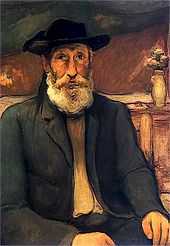Władysław Ślewiński

Władysław Ślewiński (1 June 1856 — 24 March 1918[1]) was a Polish painter. He was one of Gauguin's students and a leading artist of the Young Poland movement.[2]
Biography
Władysław Ślewiński was a Polish painter. He administered his estate in Poland before traveling to Paris in 1888. Once there he studied at the Académie Colarossi where he met Gauguin. The impression this encounter made on him and Gauguin's encouragement prompted Slewinski to dedicate himself to art. He submitted to Gauguin's artistic and personal influence, spending time with him in Paris and, from 1889, in Pont-Aven and Le Pouldu in Brittany.
Seascapes painted during this period include Cliffs in Brittany. In 1891 Gauguin painted a portrait of Slewinski and presented it to him. During this period Slewinski exhibited in Paris, with some success, both at the Salon des Independents from 1895-1896 and the Galerie Georges Thomas from 1897-1898.
Philosophy

Ślewiński's philosophy of art seems to stem from an excerpted statement of his about Gauguin: "He is so much an artist that he has to be wholly accepted or else rejected. I can feel him and accept him totally, for he suits my ideas of art and beauty". Beginning with his early works, he simplified forms and painted in flat areas. He encircled areas with contours, though he sometimes blended color into color. While he sometimes verged on abstraction, his lighting never departed completely from direct observation of nature. His approach to so-called subjective color was similar, as can be seen in some of the landscapes from the Tatra Mountains.
Perhaps more important for Ślewiński than the selective application of synthetism was his search – inspired by Gauguin – for simplicity and sincerity in places untouched by modern civilization as well as in objects of daily use. In his art, Ślewiński concentrated on the object, infusing its materiality with the reflective sensitivity of a painter. The form and color determined the painting's atmosphere. The artist used mainly earth colors, sometimes enlivened with stronger accents. He employed a repertoire of forms with curving contours, and painted without a drawn sketch, as was characteristic of the epoch.
References
- ↑ "Ślewiński Władysław". Encyklopedia PWN (in Polish). PWN. Retrieved 18 February 2013.
- ↑ Młoda Polska. "Władysław Ślewiński". Młoda Polska.pl. Retrieved 18 August 2011.
External links
 Media related to Władysław Ślewiński at Wikimedia Commons
Media related to Władysław Ślewiński at Wikimedia Commons- Works
|